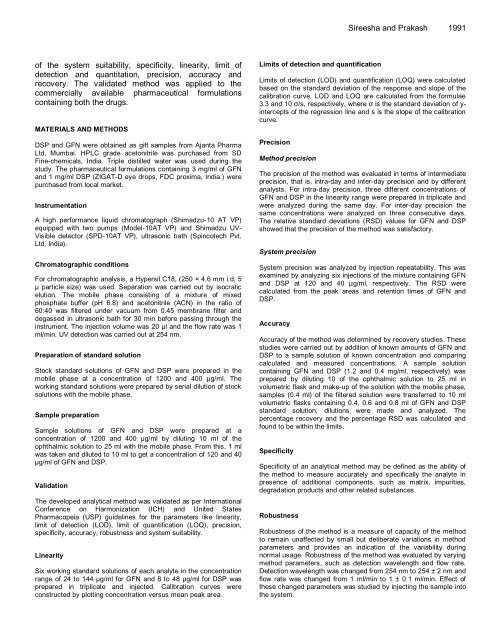Download Complete Issue (3090kb) - Academic Journals
Download Complete Issue (3090kb) - Academic Journals
Download Complete Issue (3090kb) - Academic Journals
Create successful ePaper yourself
Turn your PDF publications into a flip-book with our unique Google optimized e-Paper software.
of the system suitability, specificity, linearity, limit of<br />
detection and quantitation, precision, accuracy and<br />
recovery. The validated method was applied to the<br />
commercially available pharmaceutical formulations<br />
containing both the drugs.<br />
MATERIALS AND METHODS<br />
DSP and GFN were obtained as gift samples from Ajanta Pharma<br />
Ltd, Mumbai. HPLC grade acetonitrile was purchased from SD<br />
Fine-chemicals, India. Triple distilled water was used during the<br />
study. The pharmaceutical formulations containing 3 mg/ml of GFN<br />
and 1 mg/ml DSP (ZIGAT-D eye drops, FDC proxima, India.) were<br />
purchased from local market.<br />
Instrumentation<br />
A high performance liquid chromatograph (Shimadzu-10 AT VP)<br />
equipped with two pumps (Model-10AT VP) and Shimadzu UV-<br />
Visible detector (SPD-10AT VP), ultrasonic bath (Spincotech Pvt.<br />
Ltd, India).<br />
Chromatographic conditions<br />
For chromatographic analysis, a Hypersil C18, (250 × 4.6 mm i.d, 5<br />
µ particle size) was used. Separation was carried out by isocratic<br />
elution. The mobile phase consisting of a mixture of mixed<br />
phosphate buffer (pH 6.8) and acetonitrile (ACN) in the ratio of<br />
60:40 was filtered under vacuum from 0.45 membrane filter and<br />
degassed in ultrasonic bath for 30 min before passing through the<br />
instrument. The injection volume was 20 µl and the flow rate was 1<br />
ml/min. UV detection was carried out at 254 nm.<br />
Preparation of standard solution<br />
Stock standard solutions of GFN and DSP were prepared in the<br />
mobile phase at a concentration of 1200 and 400 µg/ml. The<br />
working standard solutions were prepared by serial dilution of stock<br />
solutions with the mobile phase.<br />
Sample preparation<br />
Sample solutions of GFN and DSP were prepared at a<br />
concentration of 1200 and 400 µg/ml by diluting 10 ml of the<br />
ophthalmic solution to 25 ml with the mobile phase. From this, 1 ml<br />
was taken and diluted to 10 ml to get a concentration of 120 and 40<br />
µg/ml of GFN and DSP.<br />
Validation<br />
The developed analytical method was validated as per International<br />
Conference on Harmonization (ICH) and United States<br />
Pharmacopeia (USP) guidelines for the parameters like linearity,<br />
limit of detection (LOD), limit of quantification (LOQ), precision,<br />
specificity, accuracy, robustness and system suitability.<br />
Linearity<br />
Six working standard solutions of each analyte in the concentration<br />
range of 24 to 144 µg/ml for GFN and 8 to 48 µg/ml for DSP was<br />
prepared in triplicate and injected. Calibration curves were<br />
constructed by plotting concentration versus mean peak area.<br />
Limits of detection and quantification<br />
Sireesha and Prakash 1991<br />
Limits of detection (LOD) and quantification (LOQ) were calculated<br />
based on the standard deviation of the response and slope of the<br />
calibration curve. LOD and LOQ are calculated from the formulae<br />
3.3 and 10 σ/s, respectively, where σ is the standard deviation of yintercepts<br />
of the regression line and s is the slope of the calibration<br />
curve.<br />
Precision<br />
Method precision<br />
The precision of the method was evaluated in terms of intermediate<br />
precision, that is, intra-day and inter-day precision and by different<br />
analysts. For intra-day precision, three different concentrations of<br />
GFN and DSP in the linearity range were prepared in triplicate and<br />
were analyzed during the same day. For inter-day precision the<br />
same concentrations were analyzed on three consecutive days.<br />
The relative standard deviations (RSD) values for GFN and DSP<br />
showed that the precision of the method was satisfactory.<br />
System precision<br />
System precision was analyzed by injection repeatability. This was<br />
examined by analyzing six injections of the mixture containing GFN<br />
and DSP at 120 and 40 µg/ml, respectively. The RSD were<br />
calculated from the peak areas and retention times of GFN and<br />
DSP.<br />
Accuracy<br />
Accuracy of the method was determined by recovery studies. These<br />
studies were carried out by addition of known amounts of GFN and<br />
DSP to a sample solution of known concentration and comparing<br />
calculated and measured concentrations. A sample solution<br />
containing GFN and DSP (1.2 and 0.4 mg/ml, respectively) was<br />
prepared by diluting 10 of the ophthalmic solution to 25 ml in<br />
volumetric flask and make-up of the solution with the mobile phase,<br />
samples (0.4 ml) of the filtered solution were transferred to 10 ml<br />
volumetric flasks containing 0.4, 0.6 and 0.8 ml of GFN and DSP<br />
standard solution, dilutions were made and analyzed. The<br />
percentage recovery and the percentage RSD was calculated and<br />
found to be within the limits.<br />
Specificity<br />
Specificity of an analytical method may be defined as the ability of<br />
the method to measure accurately and specifically the analyte in<br />
presence of additional components, such as matrix, impurities,<br />
degradation products and other related substances.<br />
Robustness<br />
Robustness of the method is a measure of capacity of the method<br />
to remain unaffected by small but deliberate variations in method<br />
parameters and provides an indication of the variability during<br />
normal usage. Robustness of the method was evaluated by varying<br />
method parameters, such as detection wavelength and flow rate.<br />
Detection wavelength was changed from 254 nm to 254 ± 2 nm and<br />
flow rate was changed from 1 ml/min to 1 ± 0.1 ml/min. Effect of<br />
these changed parameters was studied by injecting the sample into<br />
the system.

















